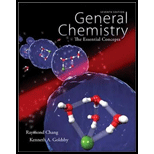
Interpretation:
From the calculation of radius and density the unknown alkali metal has to be identified.
Concept Introduction:
The radius of a body-centered cubic unit cell:
Volume of the cubic unit cell:
The edge length of the cubic unit cell:
Answer to Problem 12.126SP
The unknown alkali-metal is found to be Sodium.
Explanation of Solution
Given data:
Vapor pressure
Temperature
Volume
It is known that
Calculating the number of moles of the unknown alkali metal:
The ideal gas equation is
Converting pressure from
Substituting all the values in the ideal gas equation:
So, the number of moles of the unknown alkali metal is
Calculating the volume/mol:
Given: Edge length is
The relation between volume and the edge length is
Thus, the volume of the body centered cubic unit cell is
Converting volume/mol into volume/unit cell:
Thus the volume of the unit cell is
Calculating the edge length with respect to this volume:
Thus the edge length is
It is known that all alkali metals have a body-centered cubic structure.
So, calculating the radius of the unknown alkali-metal in the body-centered cubic structure.
The radius of for a body-centered cubic unit cell can be expressed as follows:
Converting radius from centimeters into picometers:
Thus the radius is
Figure
This calculated radius is the radius of sodium metal.
So, the unknown metal is found to be sodium metal.
Calculating the mass of sodium metal:
Since sodium metal is in body-centered cubic lattice, hence there will be 2 atoms per unit cell.
The molar mass of sodium is 23 amu which is the mass of 1 sodium atom and the mass of
So, the 2 atoms of sodium per unit cell can be calculated as follows:
So, the mass of
The volume of the unit cell has been calculated as
With all these calculations, calculating the density of sodium metal:
The actual density of sodium is known to be
From the calculation of radius, the unknown alkali metal has been identified and from the calculation of density, the identification has been proved.
Want to see more full solutions like this?
Chapter 12 Solutions
GENERAL CHEMISTRY >IC<
 ChemistryChemistryISBN:9781305957404Author:Steven S. Zumdahl, Susan A. Zumdahl, Donald J. DeCostePublisher:Cengage Learning
ChemistryChemistryISBN:9781305957404Author:Steven S. Zumdahl, Susan A. Zumdahl, Donald J. DeCostePublisher:Cengage Learning ChemistryChemistryISBN:9781259911156Author:Raymond Chang Dr., Jason Overby ProfessorPublisher:McGraw-Hill Education
ChemistryChemistryISBN:9781259911156Author:Raymond Chang Dr., Jason Overby ProfessorPublisher:McGraw-Hill Education Principles of Instrumental AnalysisChemistryISBN:9781305577213Author:Douglas A. Skoog, F. James Holler, Stanley R. CrouchPublisher:Cengage Learning
Principles of Instrumental AnalysisChemistryISBN:9781305577213Author:Douglas A. Skoog, F. James Holler, Stanley R. CrouchPublisher:Cengage Learning Organic ChemistryChemistryISBN:9780078021558Author:Janice Gorzynski Smith Dr.Publisher:McGraw-Hill Education
Organic ChemistryChemistryISBN:9780078021558Author:Janice Gorzynski Smith Dr.Publisher:McGraw-Hill Education Chemistry: Principles and ReactionsChemistryISBN:9781305079373Author:William L. Masterton, Cecile N. HurleyPublisher:Cengage Learning
Chemistry: Principles and ReactionsChemistryISBN:9781305079373Author:William L. Masterton, Cecile N. HurleyPublisher:Cengage Learning Elementary Principles of Chemical Processes, Bind...ChemistryISBN:9781118431221Author:Richard M. Felder, Ronald W. Rousseau, Lisa G. BullardPublisher:WILEY
Elementary Principles of Chemical Processes, Bind...ChemistryISBN:9781118431221Author:Richard M. Felder, Ronald W. Rousseau, Lisa G. BullardPublisher:WILEY





